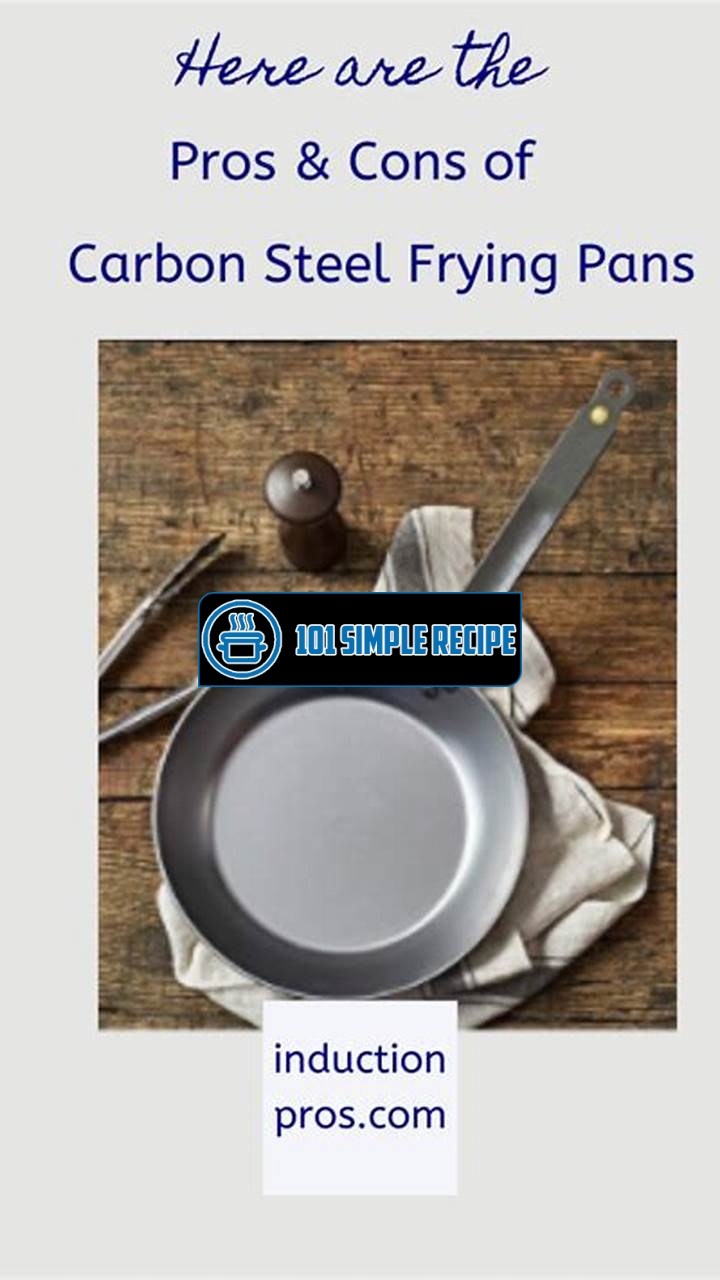Are you looking for the perfect frying pan to add to your kitchen arsenal? Look no further than the carbon steel frying pan! This versatile cookware has gained popularity among chefs and home cooks alike for its impressive heat retention and distribution capabilities. Not only does it excel at searing and browning your favorite dishes, but it also offers a lightweight and durable option for all your cooking needs. However, before making a purchase, it’s essential to consider both the pros and cons of owning a carbon steel frying pan. Let’s dive in and explore the advantages and disadvantages of this kitchen essential.

Understanding Carbon Steel Frying Pans
Carbon steel frying pans are a popular choice among professional chefs and home cooks alike. They are known for their versatility, durability, and excellent heat retention properties. In this article, we will delve into the characteristics, benefits, and drawbacks of carbon steel frying pans.
What is a Carbon Steel Frying Pan?
A carbon steel frying pan is made from an alloy of iron and carbon. It is renowned for its high heat conductivity, allowing for even and efficient cooking. The pan has a smooth surface and a naturally nonstick quality, which improves with seasoning. Seasoning involves applying a thin layer of oil to the pan and heating it to create a polymerized layer that prevents food from sticking.
Carbon steel pans are often compared to cast iron pans due to their similar characteristics. However, carbon steel pans are generally lighter and more responsive to changes in heat. They also heat up faster, making them ideal for searing and stir-frying.
Advantages of Carbon Steel Frying Pans
1. Excellent heat retention: Carbon steel frying pans have the ability to retain and distribute heat evenly, ensuring that your food cooks consistently. This feature is particularly beneficial for dishes that require precise temperature control.
2. Versatility: Carbon steel pans are incredibly versatile and can be used for various cooking methods, including frying, sautéing, searing, and baking in the oven. They can handle high heat and are suitable for both stovetop and oven use.
3. Lightweight: Compared to cast iron pans, carbon steel pans are significantly lighter, making them easier to handle and maneuver in the kitchen. This is especially advantageous when tossing and flipping ingredients during stir-frying.
4. Naturally nonstick: With proper seasoning, carbon steel pans develop a natural nonstick surface that improves over time. This means you can reduce the amount of oil or fat needed for cooking, making it a healthier option.
5. Durability: Carbon steel pans are built to last. They can withstand high temperatures and are less prone to warping or cracking compared to other materials. When properly cared for, a carbon steel pan can provide years of reliable cooking performance.
Disadvantages of Carbon Steel Frying Pans
1. Requires seasoning: Unlike nonstick pans, carbon steel frying pans need to be seasoned regularly to maintain their nonstick properties. Seasoning can be a time-consuming process that involves cleaning, drying, and applying oil to the pan.
2. Reactive to acidic foods: Carbon steel is reactive to acidic foods, such as tomatoes or vinegar-based sauces. It can cause a metallic taste and discoloration on the pan’s surface. To avoid this, it’s recommended to use non-acidic ingredients or a well-seasoned pan.
3. Requires proper care: Carbon steel pans require special care to prevent rusting and maintain their seasoning. They should be hand washed, dried thoroughly, and lightly coated with oil before storing. Scrubbing with abrasive materials or using harsh detergents can damage the seasoning.
4. Initial maintenance: When you first purchase a carbon steel pan, it will require initial seasoning and cleaning to remove any protective coating. This process can take some time and effort before the pan is ready for use.
In conclusion, carbon steel frying pans offer excellent heat retention, versatility, and durability. While they require regular seasoning and proper care, the benefits they provide in terms of performance and cooking results make them a favorite choice among professional chefs and cooking enthusiasts.
Seasoning a Carbon Steel Frying Pan
Seasoning a carbon steel frying pan is an essential step to achieve optimal cooking performance. By creating a natural non-stick surface, seasoning allows you to cook your favorite dishes with ease. In this section, we will guide you through the process of seasoning a carbon steel frying pan and provide tips on how to maintain its seasoning.
Why Seasoning is Important
Seasoning a carbon steel frying pan serves several important purposes. First and foremost, it creates a protective layer on the surface of the pan, preventing it from rusting. Carbon steel is prone to rust and oxidation, and seasoning helps to inhibit these processes.
Additionally, seasoning enhances the non-stick properties of the pan. When the pan is properly seasoned, food is less likely to stick to the surface, making it easier to cook and clean. This not only improves cooking performance but also extends the lifespan of the pan.
Furthermore, a well-seasoned carbon steel frying pan develops a unique flavor over time. This seasoning flavor adds depth and richness to your dishes, enhancing the overall cooking experience.
Steps to Seasoning a Carbon Steel Frying Pan
Now that you understand the importance of seasoning, let’s delve into the steps to achieve a perfectly seasoned carbon steel frying pan.
- Clean the pan: Before seasoning, ensure that your pan is thoroughly clean. Use hot water and a mild dish soap to remove any dust, dirt, or factory coatings. Rinse the pan well and dry it thoroughly.
- Apply oil: Next, apply a thin layer of oil to the entire surface of the pan. You can use flaxseed oil, vegetable oil, or any oil with a high smoke point. Rub the oil in using a paper towel or a cloth, making sure to cover all areas, including the handle.
- Heat the pan: Place the oiled pan on the stovetop over medium heat. Allow the pan to heat up gradually for about 10 minutes. This heating process helps the oil to bond with the pan’s surface, creating the non-stick coating.
- Repeat the process: Once the pan has heated up, remove it from the heat and let it cool down completely. Then, repeat steps 2 and 3 at least three to four times to build up the seasoning layers.
Note: The more layers of seasoning you build, the better the non-stick properties of your pan will become. It may take a few rounds of seasoning to achieve the desired results.
Tips for Maintaining Seasoning
To ensure the longevity of your pan’s seasoning, here are some essential tips to follow:
- Avoid using metal utensils: Metal utensils can scratch the seasoning layer, so opt for wooden or silicone utensils instead.
- Hand wash only: Avoid using harsh detergents or abrasive scrubbers that can strip away the seasoning. Instead, wash your pan by hand with mild dish soap and a non-abrasive sponge.
- Dry thoroughly: After washing, make sure to dry your pan thoroughly to prevent any moisture from causing rust or damaging the seasoning.
- Apply a thin layer of oil: After each use, wipe your pan with a thin layer of oil to maintain its seasoning and prevent rust.
By following these steps and tips, you can enjoy the benefits of a well-seasoned carbon steel frying pan for years to come. Seasoning not only enhances cooking performance but also adds a touch of flavor to your culinary creations. Start seasoning your carbon steel frying pan today and elevate your cooking experience!
Cooking with a Carbon Steel Frying Pan
When it comes to cooking, a carbon steel frying pan offers a plethora of benefits that make it a popular choice among both professional chefs and home cooks. Its exceptional heat distribution and retention, non-stick properties, and versatility in cooking methods make it an indispensable tool in the kitchen.
Heat Distribution and Retention
One of the key advantages of cooking with a carbon steel frying pan is its excellent heat distribution. Unlike other materials, such as stainless steel or cast iron, carbon steel pans heat up quickly and evenly across the surface. This means that your food will cook more evenly, preventing hot spots and ensuring that every bite is perfectly cooked.
Moreover, carbon steel pans have impressive heat retention capabilities. Once heated, they can maintain a consistent temperature, allowing for precise cooking control. This is especially beneficial when searing meats or stir-frying vegetables, as the high heat ensures a nice caramelization on the outside while keeping the insides tender.
Non-Stick Properties
Another advantage of using a carbon steel frying pan is its natural non-stick properties. Over time, with proper seasoning and use, a carbon steel pan develops a non-stick surface that improves with each use. This means that you can cook with less oil or butter, resulting in healthier meals. Additionally, the non-stick surface makes cleaning a breeze, as food particles are less likely to stick to the pan.
It’s important to note that while carbon steel pans do have non-stick properties, they are not entirely comparable to Teflon-coated pans. However, with proper care and seasoning, they can provide a similar level of non-stickiness without the worry of harmful chemicals.
Versatility in Cooking Methods
One of the standout features of a carbon steel frying pan is its versatility in cooking methods. Whether you’re baking, frying, sautéing, or even deep-frying, a carbon steel pan can handle it all. Its high heat resistance makes it suitable for use in the oven, on the stovetop, and even on a grill.
Additionally, carbon steel pans are compatible with all heat sources, including gas, electric, and induction. This makes them a go-to choice for any type of cookware setup. Whether you’re a professional chef cooking in a state-of-the-art kitchen or a home cook with a modest stovetop, a carbon steel frying pan is an excellent investment.
In conclusion, a carbon steel frying pan offers a multitude of benefits that make it a must-have in any kitchen. Its superior heat distribution and retention, non-stick properties, and versatility in cooking methods make it an ideal choice for various cooking applications. So why not give it a try and elevate your cooking experience to a whole new level?
Caring for Your Carbon Steel Frying Pan
Properly caring for your carbon steel frying pan is essential to ensure its longevity and maintain its excellent cooking performance. By following the right cleaning and maintenance practices, you can keep your pan in top shape for years to come.
Cleaning Techniques
When it comes to cleaning your carbon steel frying pan, there are a few important techniques to keep in mind.
- Hand wash only: Unlike some pans that are dishwasher safe, carbon steel frying pans should always be hand washed. This is because the harsh detergent and high heat in dishwashers can damage the seasoning and cause rusting. Wash the pan with warm water and a small amount of mild dish soap.
- Use a soft sponge: Avoid using abrasive scrubbers or steel wool that can scratch the pan’s surface. Instead, opt for a soft sponge or cloth to gently clean the pan.
- Dry thoroughly: After washing, make sure to dry the pan thoroughly to prevent any moisture from causing rust. Use a kitchen towel or paper towels to remove excess water, and then let the pan air dry completely before storing.
Preventing Rust
Rust is the enemy of carbon steel frying pans, but with proper care, you can prevent it from occurring.
- Season your pan: Seasoning creates a protective layer on the pan’s surface, making it more resistant to rust. To season your carbon steel frying pan, coat it with a thin layer of vegetable oil and heat it over medium-high heat for about 10 minutes. Let it cool, remove any excess oil, and you’re good to go.
- Avoid soaking: While it’s important to keep your pan clean, soaking it in water for extended periods can lead to rust formation. Instead, wash and dry your pan immediately after use.
- Re-season when necessary: Over time, the seasoning on your pan may start to wear off. If you notice signs of rust or food sticking to the surface, it’s time to re-season. Simply follow the seasoning process mentioned above to restore your pan’s protective layer.
Storing the Pan
Proper storage of your carbon steel frying pan is just as important as its cleaning and maintenance.
- Avoid stacking: Stacking your pans can lead to scratches and damage to the seasoning. To prevent this, place a soft cloth or paper towel between each pan when stacking them in your cabinet.
- Hang it up: If you have space, consider hanging your pan instead of stacking it. This not only prevents damage but also allows for better airflow, reducing the chances of moisture buildup and rust formation.
- Store in a dry place: Always store your carbon steel frying pan in a cool, dry place. Avoid storing it in a humid environment like under the sink or near the dishwasher.
By following these cleaning and maintenance practices, you can ensure that your carbon steel frying pan remains in excellent condition and serves you well in the kitchen for years to come.
Choosing the Right Carbon Steel Frying Pan
When it comes to selecting a carbon steel frying pan, there are several factors to consider to ensure that it suits your cooking needs. From size and weight to handle design and comfort, each aspect plays a crucial role in determining the best pan for you. Additionally, the price range and brand options available can also impact your decision. Let’s dive deeper into each of these factors to help you make an informed choice.
Size and Weight
Size and weight are essential considerations when choosing a carbon steel frying pan. The pan’s diameter determines its capacity and cooking surface area. If you frequently cook for a large family or entertain guests, opting for a larger frying pan would be a wise decision. On the other hand, if you have limited stovetop space or cook for only a few people, a smaller pan would suffice.
The weight of the frying pan is another crucial factor to consider. A pan that is too heavy may be challenging to handle, especially when flipping or tossing ingredients. Conversely, a pan that is too light might not provide the necessary heat retention and even heat distribution. Finding the right balance between size and weight ensures optimal cooking performance.
Handle Design and Comfort
The handle design of a carbon steel frying pan greatly influences its ease of use and comfort while cooking. Look for a pan with a sturdy handle that is securely riveted or welded to the body. This ensures durability and prevents accidents caused by loose handles.
Comfort is equally important, as it affects your overall cooking experience. Ergonomically designed handles with a comfortable grip make it easier to maneuver the pan and maintain control while cooking. Some pans also feature handles that stay cool to the touch, preventing burns and ensuring safe handling.
Price Range and Brand Options
Consider your budget and explore the wide range of price options available for carbon steel frying pans. Higher-priced pans often offer superior quality, durability, and performance. However, there are also affordable options that provide excellent value for money.
It’s worth considering reputable brands that are known for their quality carbon steel cookware. These brands have established themselves over time with a focus on delivering reliable and long-lasting products. Researching customer reviews and ratings can provide valuable insights into the performance and durability of different brands.
In conclusion, selecting the right carbon steel frying pan involves considering various factors such as size and weight, handle design and comfort, as well as price range and brand options. By carefully assessing each aspect, you can find a frying pan that complements your cooking needs and enhances your culinary adventures.
Thank you for taking the time to read our article on the pros and cons of carbon steel frying pans. We hope you found the information helpful and informative. Whether you’re a professional chef or a home cook, understanding the benefits and drawbacks of carbon steel frying pans can help you make an informed decision when choosing your cookware.
If you have any further questions or if there are any specific topics you’d like us to cover in the future, please feel free to reach out to us. We value your feedback and strive to provide valuable content for our readers.
Frequently Asked Questions
Here are some commonly asked questions about carbon steel frying pans:
| No. | Questions | Answers |
|---|---|---|
| 1. | What are the advantages of using a carbon steel frying pan? | Carbon steel frying pans offer excellent heat conductivity, durability, and versatility. They are lightweight, have a natural non-stick surface when seasoned properly, and can be used for various cooking techniques. |
| 2. | Are there any downsides to using a carbon steel frying pan? | Carbon steel frying pans require regular seasoning and maintenance to prevent rust. They also have a longer heat-up time compared to nonstick pans and can react with acidic ingredients. |
| 3. | How do I season a carbon steel frying pan? | To season a carbon steel frying pan, coat it with a thin layer of oil and heat it until the oil begins to smoke. Remove it from the heat, wipe off any excess oil, and let it cool. Repeat this process several times to develop a smooth, non-stick surface. |
| 4. | Can I use metal utensils with a carbon steel frying pan? | Yes, carbon steel frying pans are incredibly durable and can withstand the use of metal utensils without scratching or damaging the pan. |
| 5. | How do I clean a carbon steel frying pan? | After cooking, wash your carbon steel frying pan with warm water and mild soap. Avoid using abrasive sponges or harsh cleaning agents that can strip away the seasoning. Dry the pan thoroughly and coat it with a thin layer of oil to prevent rust. |
| 6. | Can I use a carbon steel frying pan on an induction cooktop? | Yes, carbon steel frying pans are compatible with induction cooktops due to their magnetic properties. |
Try Out a Carbon Steel Frying Pan Today!
Now that you’re well-informed about the pros and cons of carbon steel frying pans, it’s time to try one out for yourself. Explore the world of carbon steel cookware and elevate your cooking experience with its superior heat distribution and versatility. Remember to season and care for your carbon steel frying pan properly to ensure its longevity and optimal performance. Happy cooking!
Jump to Recipe
Carbon Steel Frying Pan Pros and Cons

Learn about the advantages and disadvantages of using a carbon steel frying pan in your kitchen. Find out why many chefs and home cooks prefer this versatile cookware option.
- 1 carbon steel frying pan
- cooking oil
- your favorite ingredients
- Coat the surface of the carbon steel frying pan with a thin layer of cooking oil. Heat the pan over medium-high heat until the oil begins to smoke. Remove the pan from the heat and let it cool. Repeat this process several times to develop a natural non-stick surface.
- Heat the carbon steel frying pan over medium heat. Add your favorite ingredients and cook them to perfection. Enjoy your delicious meal!






